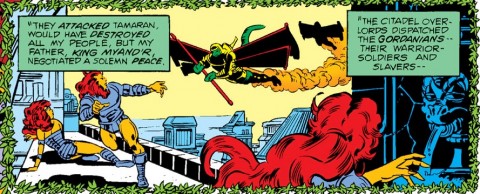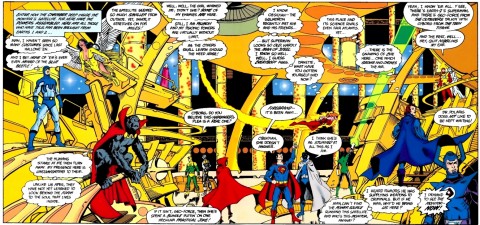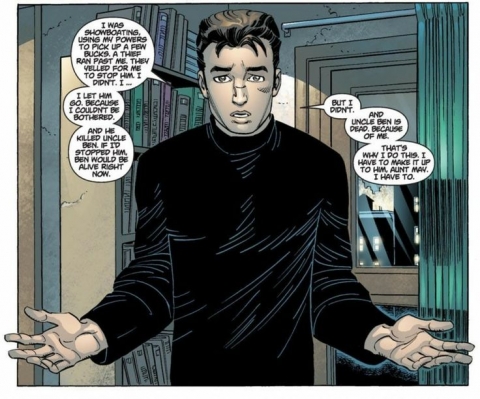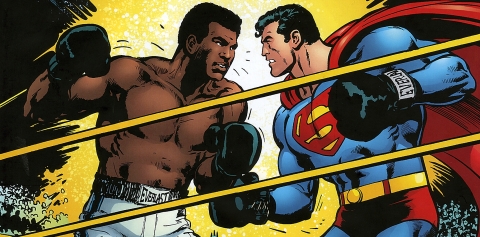52 weeks. 52 different writers. 2 trade paperbacks or hardcovers a week. Each week I’ll take a look at a different writer and read two different collected editions from within that person’s repertoire to help in the examination of their work.
Marv Wolfman is a legendary writer having jumped between the Big Two publishing companies for many years. In the early 1980’s, Wolfman came back over to DC Comics and relaunched the New Teen Titans with penciller George Perez. The New Teen Titans was an instant hit as Wolfman and Perez became a dynamic force of nature on the book. Together the two men created Starfire, Raven and Cyborg, all three of which became mainstay Teen Titans characters. More recently, the characters of Cyborg and Starfire have seen a surge in popularity, with Cyborg getting a call up to become a permanent member of the Justice League and both characters getting their own solo series this year. This only helps to solidify the lasting impression both Wolfman and Perez left on DC Comics, all starting with their New Teen Titans run.
The New Teen Titans Vol 1
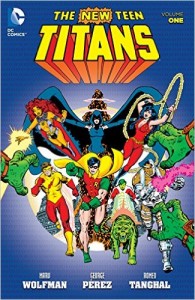 The New Teen Titans come together when the young heroes are called to prepare for an impending and great evil that heads their way. The mysterious Raven gathers Robin, Kid Flash, Wonder Girl, Cyborg, The Changling, and Starfire to form the New Teen Titans, with little time to craft this group of teenagers into a well oiled team. Coming from plenty of different walks of life, the many young heroes struggle to work together at first before discovering that they are truly stronger united than they are divided. Deathstroke, Psimon, Trigon the Terrible and many others stand between this newly reformed team and becoming the heroes they were meant to be.
The New Teen Titans come together when the young heroes are called to prepare for an impending and great evil that heads their way. The mysterious Raven gathers Robin, Kid Flash, Wonder Girl, Cyborg, The Changling, and Starfire to form the New Teen Titans, with little time to craft this group of teenagers into a well oiled team. Coming from plenty of different walks of life, the many young heroes struggle to work together at first before discovering that they are truly stronger united than they are divided. Deathstroke, Psimon, Trigon the Terrible and many others stand between this newly reformed team and becoming the heroes they were meant to be.
The early 1980’s is, in my opinion, one of the best eras in the history of comics, punctuated by the phenomenal talents of creators like Marv Wolfman and George Perez. Together, the two men crafted a roster of young heroes who are still wildly popular to this day. Taking mainstay heroes like Robin, Kid Flash, and Donna Troy as well as creating new heroes like Starfire or Cyborg, Wolfman and Perez redefined the dynamic team of the New Teen Titans. What might be lost upon fans of modern comics is how dense the comics of previous decades were. In the 90’s comics became more about gimmicks and splash pages than actually storytelling, an unfortunate tradition that still continues today in some places. But back before the 80’s, comics were a far more rich platform for telling serious or powerful stories. Wolfman’s New Teen Titans is a great example of this, displaying that you can pack a ton of story into twenty five pages. With a comic like the New Teen Titans, you have to really sink your teeth into the story, investing more of your time to read it than say your average comic published now in 2015. To put it in perspective, I can read your average length of a graphic novel for today (which is about six issues) in the range of a hour or so, whereas this volume of New Teen Titans took me multiple sitting stretched out over a couple of days and it only had roughly ten issues. There is so much text packed into every panel and page that you have to prepare yourself to actually read instead of just breeze through. It’s a beautiful thing to read comics like that, the ones that force you to actually pay attention and read because there is so much story in just a single issue. It’s not even that Marv Wolfman overloaded every panel or issue with too many words, as far as I can see he still abides to the “Stan Lee rule” of 28 words per panel as a maximum but it’s the fact that there are more panels per page than your average comic nowadays that impacts the amount of time it will take you to read.
Like I said in the previous paragraph, each issue in this collection is a rather dense read and I mean that in only the best of ways. For twenty five pages of story you definitely get the bang for your buck as there is so much happening story wise every issue. Each issue has a clear beginning, middle, and end, reading like a three act play. Even with that in mind for every issue, Wolfman still strings together issues to make arcs but you get the genuine sense from his strong storytelling that you never actually have to read the previous issue to understand what the story is actually about. Instead, if an issue is the second part of the arc, that issue will quickly bring you up to speed on the happenings in the story clearly, using character dialogue to seamlessly explain what you may have missed if you never read the issue before. It’s a style of storytelling that feels lost in today’s comic market, with every issue needing to be closely intertwined with the one before. Wolfman shows the best of his style of storytelling right in the middle of the volume with issues 5 through 7, following along with the “Trigon The Terrible” saga. Each issue connects with the one before and after it but still stands out on its own as a sole body of work. As such, you can take away compelling stories from just reading each of those issues independently or take away an even more engaging story by reading them all back to back. Wolfman does such an amazing job with Perez in telling a story that you can’t help but keep reading.
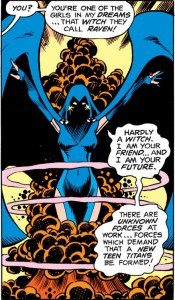 Wolfman and Perez certainly have what feels like a rather deep pool of characters to draw from for their work on New Teen Titans, seemingly using as many well established characters as they do for the ones they create. Each member of the New Teen Titans feels vital to it’s success, either during the present narrative or down the road in the future. With Robin, Wolfman and Perez have a clearly designated leader for the group, using Dick Grayson’s experience as the linchpin for what keeps the group together. One could argue that Grayson is the most well connected DC character across the entire line due to all his different affiliations and as such, it makes him a clear candidate for leadership. Then Wolfman sprinkles in the character of Starfire, a beautiful, gold skinned alien who was the prisoner to another alien race for a time. Her escape to Earth makes her an immediate romantic element in Dick Grayson’s life and her youthful nature mixes with her naivety as well as her sense of wonder towards Earth to make a compelling character. With Cyborg, Wolfman and Perez really try to tug on the reader’s heartstrings, stripping Vic Stone at any chance of a normal life by making him a robotic freak. He is resentful of his father for making him Cyborg following an unexpected lab accident, feeling robbed of a successful athletic caree. Over the course of the story they chip away at the hard exterior of Cyborg to make a great character who learns and experiences so much. I could genuinely spend all day examining the characters and their arcs from just this collection alone but the development of these characters is better experienced by reading the comic than it is from reading this post. Trust me when I say, it’s worth investing your time into all of these characters.
Wolfman and Perez certainly have what feels like a rather deep pool of characters to draw from for their work on New Teen Titans, seemingly using as many well established characters as they do for the ones they create. Each member of the New Teen Titans feels vital to it’s success, either during the present narrative or down the road in the future. With Robin, Wolfman and Perez have a clearly designated leader for the group, using Dick Grayson’s experience as the linchpin for what keeps the group together. One could argue that Grayson is the most well connected DC character across the entire line due to all his different affiliations and as such, it makes him a clear candidate for leadership. Then Wolfman sprinkles in the character of Starfire, a beautiful, gold skinned alien who was the prisoner to another alien race for a time. Her escape to Earth makes her an immediate romantic element in Dick Grayson’s life and her youthful nature mixes with her naivety as well as her sense of wonder towards Earth to make a compelling character. With Cyborg, Wolfman and Perez really try to tug on the reader’s heartstrings, stripping Vic Stone at any chance of a normal life by making him a robotic freak. He is resentful of his father for making him Cyborg following an unexpected lab accident, feeling robbed of a successful athletic caree. Over the course of the story they chip away at the hard exterior of Cyborg to make a great character who learns and experiences so much. I could genuinely spend all day examining the characters and their arcs from just this collection alone but the development of these characters is better experienced by reading the comic than it is from reading this post. Trust me when I say, it’s worth investing your time into all of these characters.
The only genuine and glaring weakness I found in this series of stories by Wolfman and Perez is how they portrayed Raven at times but even then it falls within the parameters of the era of comics these stories fall in more than anything else. It feels like there is hardly an issue that goes by where you don’t see Raven as a sobbing mess on the page, crying seemingly at least once an issue after the first handful of stories. As such, these moments really work to strip away all the other solid work done with some of the other female characters like Starfire or Donna Troy. Raven is displayed as strong time and time again only to have that robbed away from her by making her an emotional train wreck of a character. Again, I believe that this is all a byproduct of that era of comics more so than the actually intention of Wolfman or Perez.
Collects: DC Showcase Presents #26, The New Teen Titans #1-8
Best Character: Cyborg
Best Line Of Dialogue/Caption: “Wondy you’re a spoil sport. Don’tcha know I love having bats for dinner?” – The Changling
Best Scene/Moment: Cyborg meets a group of children with prosthetic limbs – Issue 9
Best Issue: Issues 4-6. I’m cheating on my choice and don’t even care. The entire Trigon arc is truly incredible stuff from Wolfman and Perez, making this entire volume of stories worth purchasing for this arc alone! There’s tons of character development and awesome moments to pick from here. You have the first fight between JLA and The New Teen Titans, the Teen Titans learning to be a team, or even their climatic battle against Trigon. No matter where you look there are tons of great moments in this arc but more importantly there’s a fantastic story happening the entire time. Cool moments are important but a great story being memorable is far more important.
Why You Should Read It: This is a fantastic era in comics, reminding readers that comics can be fun and still tell serious stories. Wolfman and Perez tell some timeless tales with this collection of their work on The New Teen Titans. There’s tons of great character development for new and old characters, thrilling villains and dense stories that you can’t help but invest yourself into. If you want good comics there’s plenty of solid stories kicking around nowadays. But if you want truly amazing stories, like some of the best ones ever told, do yourself a favour and read Wolfman and Perez’s collections of their time with The New Teen Titans.
Crisis On Infinite Earths
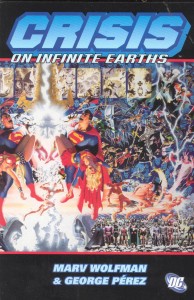 In the mid-1980’s, Marv Wolfman and George Perez teamed up yet again to bring Crisis On Infinite Earths to life. DC Comics was celebrating their 50th Anniversary and wanted to honour it in bold fashion. Wolfman and Perez crafted the 12 part series as a way to celebrate the company’s history but also clean up some of the convoluted continuity issues that have plagued the company for years. Inconsistent origins or errors in stories were all meant to be tidied up from Crisis as it combined several different universes into one, streamlined world for new and old readers alike.
In the mid-1980’s, Marv Wolfman and George Perez teamed up yet again to bring Crisis On Infinite Earths to life. DC Comics was celebrating their 50th Anniversary and wanted to honour it in bold fashion. Wolfman and Perez crafted the 12 part series as a way to celebrate the company’s history but also clean up some of the convoluted continuity issues that have plagued the company for years. Inconsistent origins or errors in stories were all meant to be tidied up from Crisis as it combined several different universes into one, streamlined world for new and old readers alike.
The Monitor, a mysterious man overlooking all of the DC multiverse, examines heroes far and wide, watching as worlds are erased from existence by an antimatter wave. With the antimatter wave’s destruction seemingly unstoppable and far reaching, The Monitor uses his ally The Harbinger to round up the mightiest of heroes across as many remaining universes as possible to help combat this terrible evil that threatens their very existence. As worlds begin to fade faster than they can be saved, The Monitor enacts a plan to have the remaining universes vibrate together so that they can exist in the same space while the heroes try to thwart the plans of the Anti Monitor and his anti matter wave once and for all.
Crisis On Infinite Earths might be one of the most ambitious crossover events to have ever occurred in comics, all thanks to the brilliant minds of Marv Wolfman and George Perez. Condensing and cleaning up over fifty years of continuity is no small feat but something that Wolfman and Perez set out to do nonetheless with this Crisis event. Drawing in seemingly ever character across all DC timelines and universes, Crisis On Infinite Earths is just as much a celebration of years past as it is a streamlined book to, at the time, introduce and welcome new readers to a cleaner version of DC history.
Although this comic features one of the largest casts you’ll ever find in a series, Wolfman still keeps his main cast trimmed and lean. This story focuses primarily on four characters: Monitor, Anti Monitor, The Harbinger, and Pariah. Although there are seemingly hundreds of other characters who are given moments in the spotlight, none are as important to the story as these characters are. Monitor at first seems almost villainous in his approach, taking mysterious steps to achieve goals that he keeps shielded from even his closest of allies. It isn’t until you’re deeply committed into the story that you start to see there are more things at play than just Monitor’s well hidden goals. About a third of the way through the story you get a better understanding of who the character is and start to root for him far more passionately as you’re given a reason to take his side. The Harbinger is a rather tragic character, being someone who means well but is ultimately used as a tool for great evil. She is tied rather closely to Monitor on a personal front which makes the fact that she actually works against him all the more difficult to stomach. Her character goes through great loss throughout but ultimately is placed on a fitting path. Pariah, too, is a tragic character, forced to watch the death of worlds from the anti matter wave as a curse. It’s his own naivety and greed that drives him to be plagued by this curse, even though the character only ever means well. The way Pariah and Harbinger’s tragic character arcs play off of each other is a true joy to watch as their unhappiness invests you in their characters.
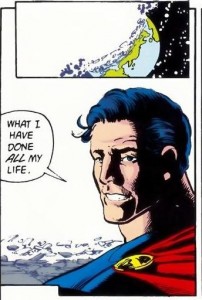 Anti Monitor is an interesting villain to place against all the heroes of this story. He checks off all the boxes to be a serious threat to everyone who opposes him: he is seemingly indestructible, immeasurably powerful, brutal, wicked, and has a masterplan that threatens all of existence. A character like Anti Matter could have easily come off as a flat, one note villain, and in some instances he truly does, but Wolfman manages to add compelling flares to the character because of how difficult he is to defeat. You watch the heroes strike out against him time and time again just to fail. You become interested in how exactly these heroes could ever actually amount to a serious attack against an enemy who can’t be defeated. It’s right around the back half of this collection where Anti Monitor becomes a truly fascinating story, watching as he strikes out against his adversaries in a way that leaves them with two fewer members in their ranks, eliciting strong emotional reactions from characters like Earth-1 Superman and Wally West, otherwise known as The Kid Flash.
Anti Monitor is an interesting villain to place against all the heroes of this story. He checks off all the boxes to be a serious threat to everyone who opposes him: he is seemingly indestructible, immeasurably powerful, brutal, wicked, and has a masterplan that threatens all of existence. A character like Anti Matter could have easily come off as a flat, one note villain, and in some instances he truly does, but Wolfman manages to add compelling flares to the character because of how difficult he is to defeat. You watch the heroes strike out against him time and time again just to fail. You become interested in how exactly these heroes could ever actually amount to a serious attack against an enemy who can’t be defeated. It’s right around the back half of this collection where Anti Monitor becomes a truly fascinating story, watching as he strikes out against his adversaries in a way that leaves them with two fewer members in their ranks, eliciting strong emotional reactions from characters like Earth-1 Superman and Wally West, otherwise known as The Kid Flash.
As I’ve already stated, the cast of this story is huge which means that the scope of this story is even larger. This is a massive event that interweaves so many different narratives from all sorts of comics and can leave you feeling a little lost at times. A story that condenses and simplifies decades of continuity errors is sure to not be as necessarily simple as the final product is intended to be. Wolfman draws in from dozens of different storylines, referencing the fact that these characters do actually have lives outside of the current “Crisis” occurring. Things like Barry Allen hiding due to his trial for murder or even Starfire’s desire to return to her home planet Tamaran are events that play out over in the series these characters are associated with but still effects what they have going on during this massive crossover.
I don’t recommend this being the first book you ever read if you’re trying to get into the DC Universe. It can be a complex and interweaving tale that is really meant to be grasped if you have at least a decent understand of the characters in the DCU. The action makes tons of quick cuts away to different characters and how they’re dealing with the destruction the Crisis brings. One minute you’re with Earth-1 Batman, the next you’re watching Jonah Hex protect a massive machine in a mine. From there you’ll transition off to watching Wildcat trying to protect civilians. Without a familiarity with at least the heroes from Earth-1, Earth-2, and even some of the ones from Earth-3, you’re sure to feel lost in a story that will get way too convoluted for you far too quickly.
To counter balance out these massive amounts of characters and story at play are some truly stunning moments. The back-to-back stunning deaths of two major DC characters in issues 7 and 8 are not just sad but also incredible to watch. These are the sort of moments comic fans wait their entire lives to read, the moments where these prestigious characters get the send offs they deserve. That’s not to say that death as a storytelling device is always acceptable, because it’s not, but instances like during issues 7 and 8, where these two heroes get these amazing deaths that send them off with justice, it’s easy to forgive the fact that death in comics is as common as changing our clothes in real life. Crisis On Infinite Earths feels as though it’s packed with an infinite amount of moments like the two I just alluded two and it’s a great story that everyone should experience at least once in their lifetime, even if these crazy kind of crossovers aren’t necessarily your cup of tea.
Collects: Crisis On Infinite Earths #1-12.
Best Character: Supergirl.
Best Line Of Dialogue/Caption: Is there beyond the silent night an endless day? Is death a door that leads to light? We cannot say. – Declaration of the Free (Issue 7’s closing statement).
Best Scene/Moment: A character makes a sacrifice – Issue 7.
Best Issue: Issue 7 – Beyond The Silent Night. There’s a certain character death from Crisis On Infinite Earths that I feel as though gets far more attention than the one that occurs in this issue. This issue is perhaps one of the best stories ever for the character who passes away here and I’m intentional being vague to not spoil a great moment for people who have never read this story. The issue itself isn’t contingent on being great because of the death that occurs. It’s a great story that just so happens to be punctuated by the death of the character who makes the story great.
Why You Should Read It: Crisis On Infinite Earths is an ambitious crossover event that would inspire comics for decades to come. It’s one of the most complex but reward crossovers ever done in comics, taking a chance to dust up some of the sloppy continuity from years past. It’s a great platform to see Marv Wolfman and George Perez reunite on, even taking chances to throw some great moments up at their beloved New Teen Titans team for years gone bye. If you’re up for the task of reading a story that will test your comic reading mind and thrill you all at the same time, look no further than this book.

